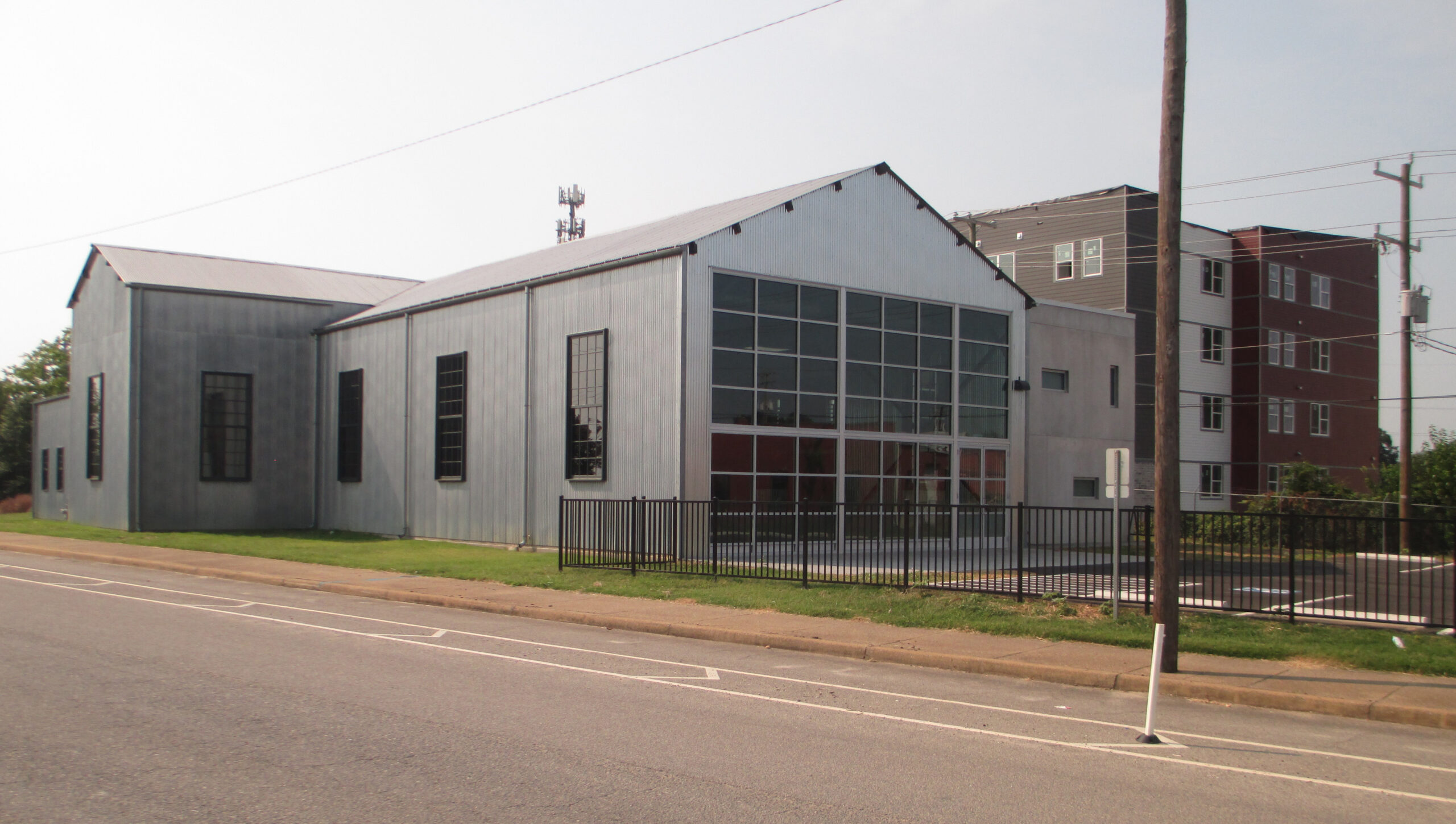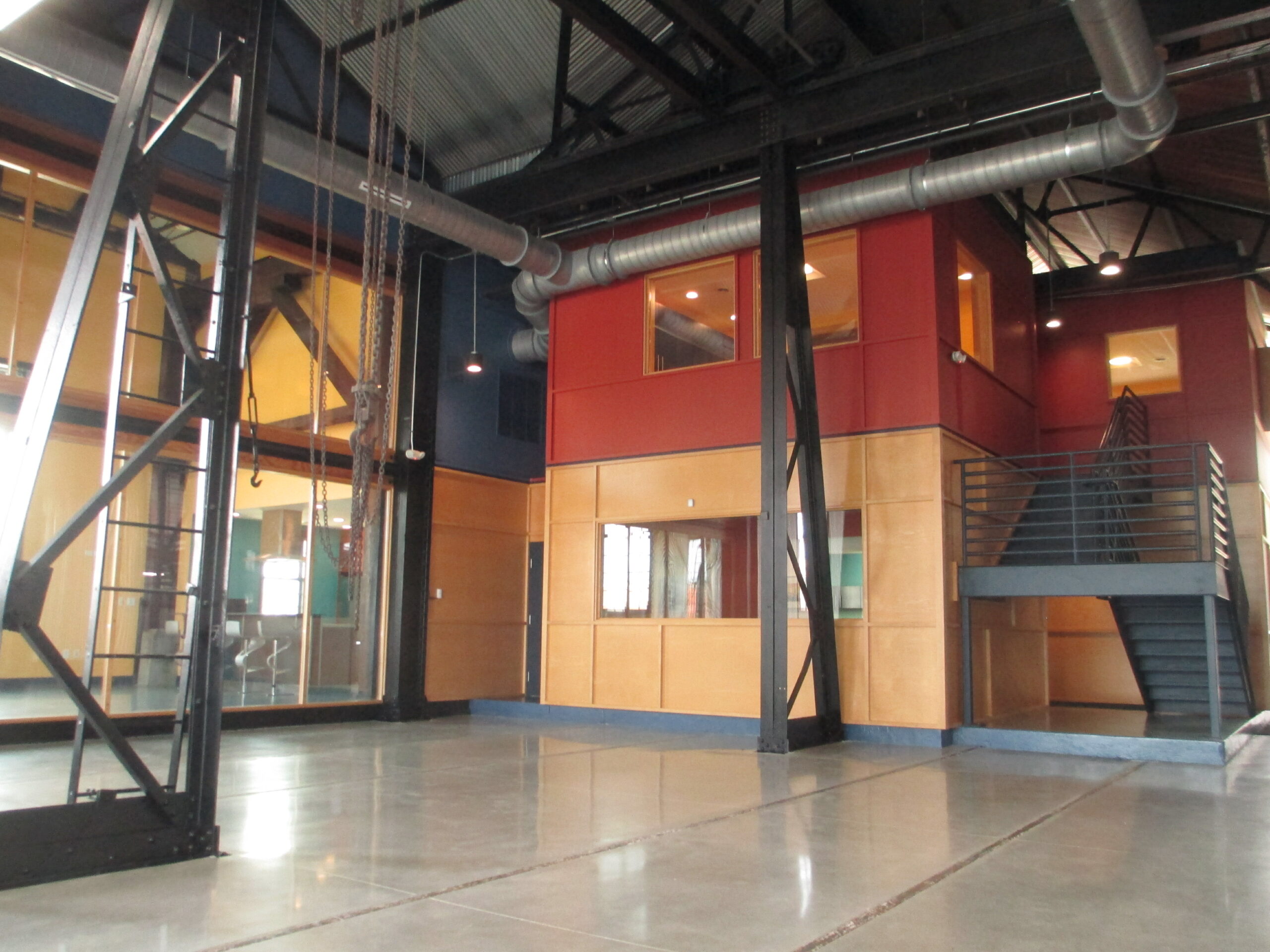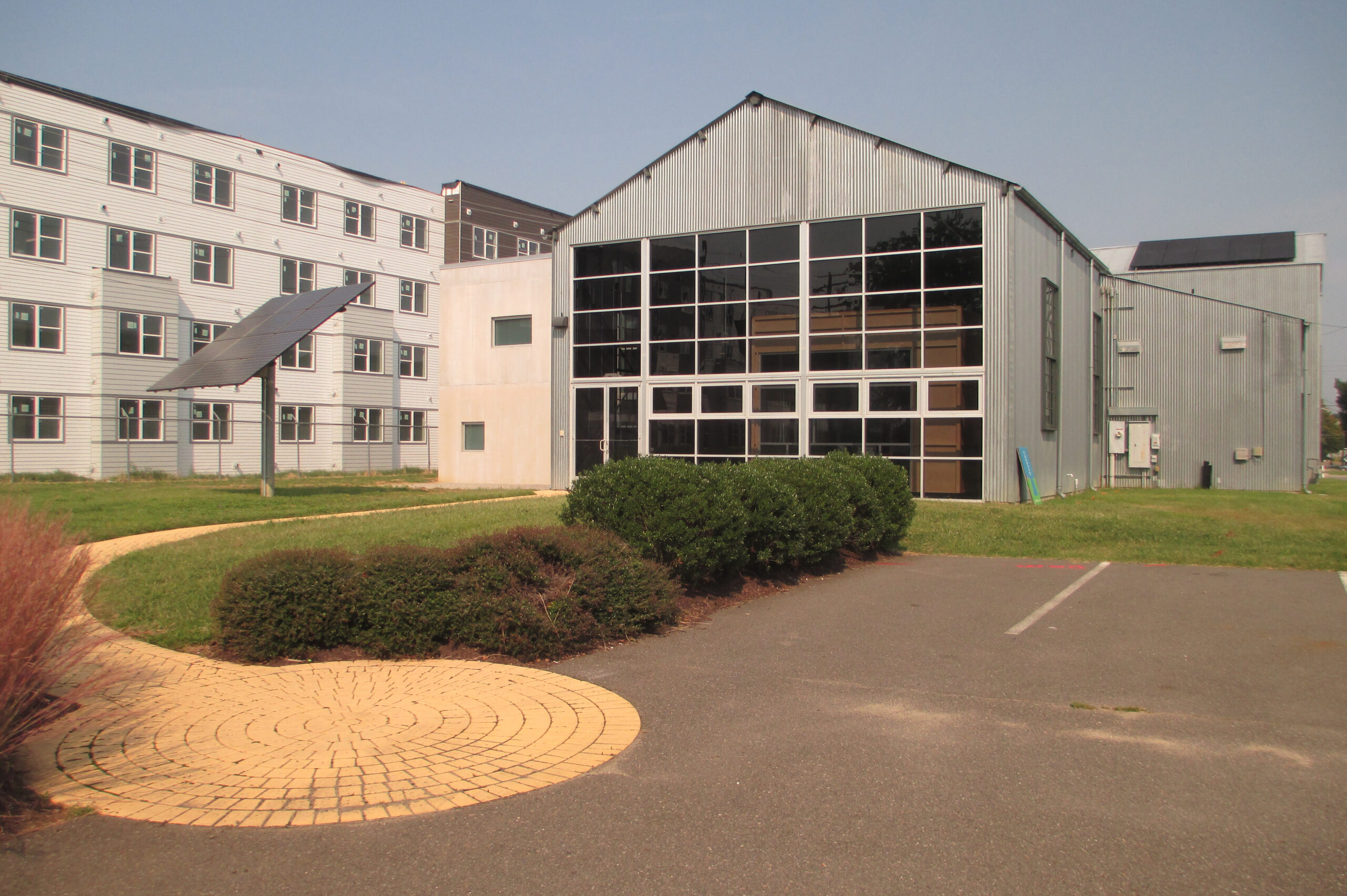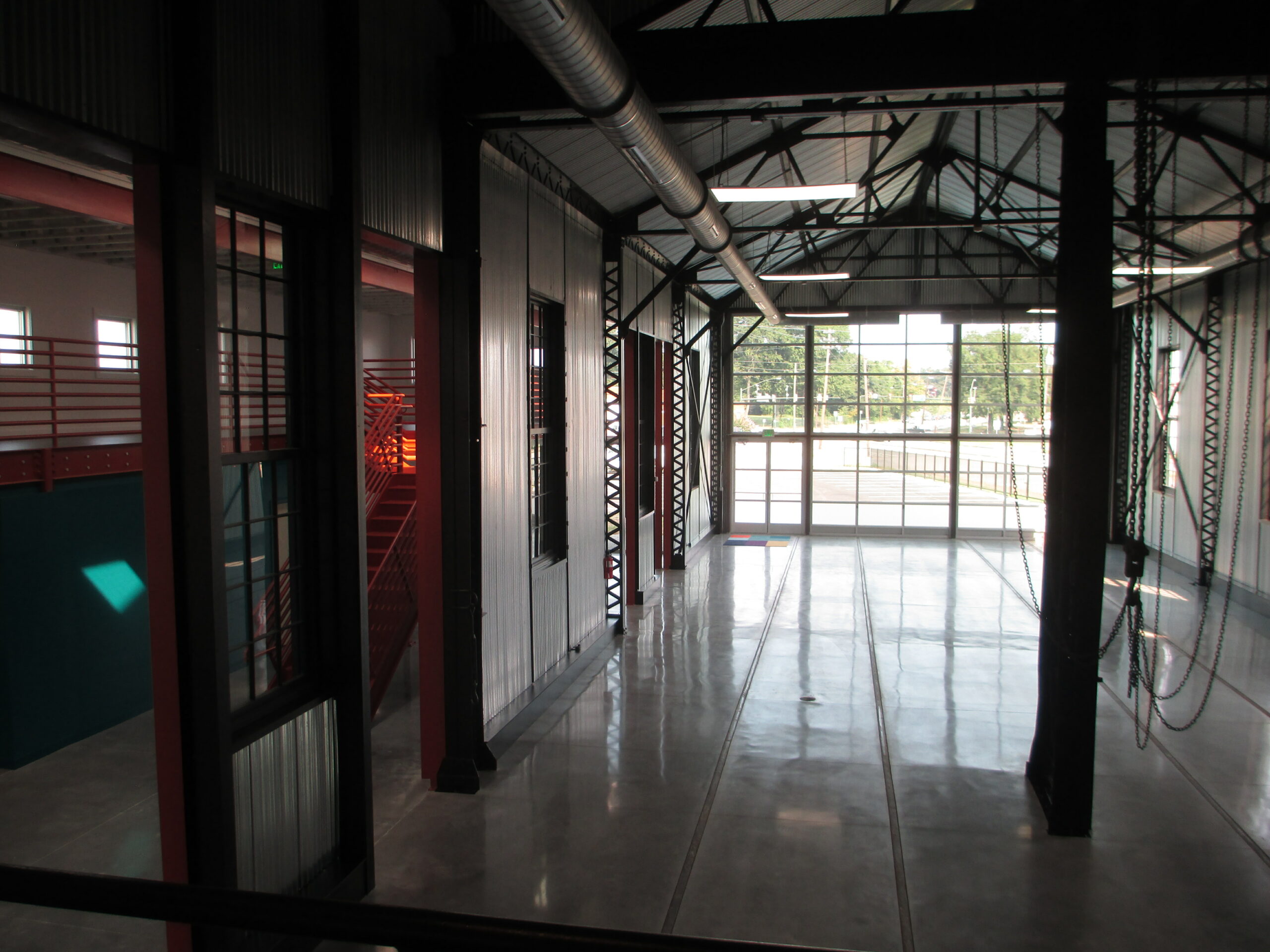Julie and Paul Weissend in the former car barn, which they converted into an office for their moving dovetail construction company. (Jonathan Spiers photos)
After turning a piece of Northside into their own version of Oz, Julie and Paul Weissend plan to hand over the keys to their industrial building, which has become an office aptly nicknamed The Emerald Barn.
The wife and husband of the owners of Dovetail Construction Co. put the building on 1620 Brook Road up for lease this week after using the former truck repair shed as their headquarters for a decade.
The move follows the recent completion of an addition that has doubled its usable space to nearly 12,000 square feet, and comes as the Weissends shift their business from mostly upscale housing to development projects like this one – making the building the first in the US to be LEED platinum and net zero energy certified and listed on the National Register of Historic Places.
“We spin personally and wanted to see how we develop things more. This is our first experiment, so to speak, ”said Julie. “We have decided to get out of the general contracting business. It was 33 years ago and we just wanted to do more strategic things – the design and the planning. “
As the only company employee, the Weissends are moving Dovetail’s offices out of the building, likely to their home on Monument Avenue, Weissend said. The company, which at times had 30 employees, engages subcontractors if necessary.

The Brook Road building dates back to 1907 and was originally used to repair electric railroad cars.
“It’s up to us and the submarines we’ve been working with for 30 years. So from an employee perspective, we no longer need a huge office, ”she said.
The Weissends will continue to own the property, which they bought for $ 250,000 in 2005 and redeveloped in 2010. With the addition completed over the last year, they have invested a total of about $ 3 million in the property, according to Paul.
The building, built in 1907, originally served as a repair barn for electric railroad cars. In the concrete floor of the building, railway lines are visible that the wagons move in and out of, and a still functional gantry crane hangs from the ceiling.
The only original part of the building is its riveted steel frame, which accentuates the interior and helps to attenuate the sound in the larger rooms of the building, Julie said.
“At that time it was state of the art. It was partially pre-fabricated, ”she said. “It’s embossed ‘Carnegie 1903’ in certain places on the frame, so they planned it out and riveted something before shipping, and then they made other components in place. That was pretty astonishing for 1907. “

The main room of the building has an operable portal crane and rails visible in the floor.
The building, which was later used to repair articulated lorries, was in disrepair when Julie found it while searching for a location for her business after working from her then home in the West End.
Julie is a fan of The Wizard of Oz and said she was drawn to the property in part because of the view of the city skyline, which she found resembled the Emerald City.
“We love ‘The Wizard of Oz’ and to me the town in the distance looks like Oz,” she said. “And we want to be inspired and let ourselves be inspired, and we want to get to a workplace that is fun.”
Weissend added, “It was kind of a joke. The company that owns this is “Yellow Brook Road,” which refers to the LLC that they bought the property with. “And in the film it’s monochrome on the outside, and we’ve done Technicolor on the inside. From then on it just went on. We literally have a yellow brick street entrance. “

A sidewalk “Gelbsteinstrasse” leads to the building. The Foundry Apartments can also be seen.
Working with Walter Parks Architects and engineering firm CMTA, the couple designed the interior of the building to look like something over the rainbow, with walls and railings accented with bright colors that contrast the gray walls and floor of the building .
The Weissends highlighted their role in Richmond’s history as the birthplace of the country’s first city-wide electric tram system and successfully applied for the tram barn to be listed on the National Register of Historic Places.
This enabled them to use tax credits for monument protection, which, according to Weissend, subsidized the cost of obtaining LEED platinum status – the highest certification awarded by the US Green Building Council for “Leadership in Energy and Environmental Design”.
“Then Paul said it would be so cool to go net zero,” she said, referring to the energy standard achieved by negating greenhouse gas emissions. “It turned out to be the first building in the United States to contain these three things: LEED Platinum, on the national register, and net zero.”

The mezzanine floor of the extension increases the rentable area of the building.
She said the expansion was prompted by plans for The Foundry apartment buildings under construction next door and the loss of the west face of her property. With skylights providing natural light from above, the window placements were designed to draw the occupants’ attention inward, she said.
“Since we knew the apartments were coming, we wanted to get out the front and then control the view and make it so that you look at the cool, fun part we created instead of in someone’s apartment window,” said Weissend.
Of the new buildings, she added: “I’m delighted with the energy and diversity. Mixed use is absolutely the way to go, and there is no such thing as an office like this. So this helps to complement the available spectrum. “
Depending on the use, the Weissends expect to rent the space between 22 and 25 US dollars per square foot. While they rated this range high for the neighborhood, they said it is justified given the quality of the building and the amount of investment and development activity that has been seen in the neighborhood recently.

A view of the main building on the second floor with the annex on the left.
Paul admitted they were just beginning such an investment and said, “It was really great to see the neighborhood change. We really wanted to improve the neighborhood as part of our job. “
As for the next steps for Dovetail, Julie said she wouldn’t say no to yet another industrial rehab, possibly for a corporate office in the future. As the company moves towards real estate development, the company’s residential work over the years has included a Mako Builders restoration of the 1920s Tudor Revival mansion at 5103 Cary Street Road as well as their own home at 2710 Monument Ave.
“I would love to do it again. I’m always on the lookout, ”she said of the company’s move towards real estate development. “I haven’t been to the Southside that often, and there are some interesting old buildings all over the Manchester area that we could possibly do something similar in.”
